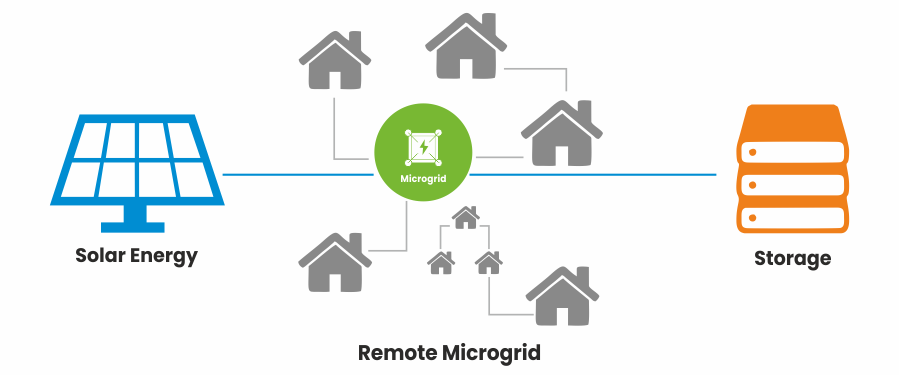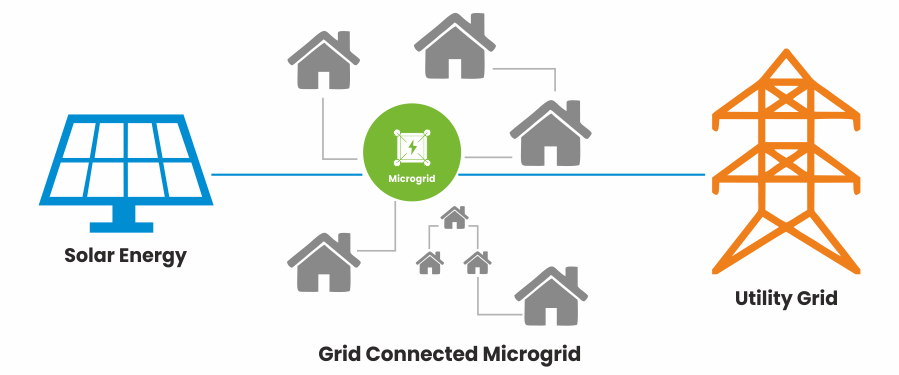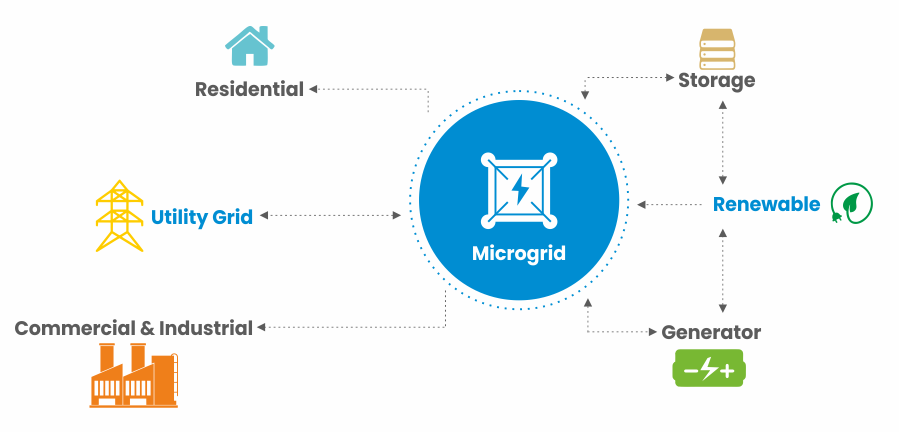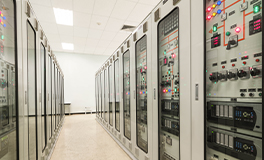The electricity that fuels your home is drawn from a centralized grid. As the cost of electricity goes up, so does the cost of transmitting power to remote places. What if this centralized grid experiences a disruption?
To avert such situations, micro-grids offer self-reliant energy systems that have the capacity to provide power to small communities independently.
What Is a Microgrid?
A microgrid is a self-sustaining electrical network that empowers you to locally produce and utilize electricity as needed. It effectively manages and regulates your facility’s distributed energy resources (DER) to improve efficiency, sustainability, and resilience. Whether in connection with the main utility grid or functioning independently, microgrids adapt seamlessly to grid failures or surges in electricity costs, offering a responsive and flexible energy solution.
Microgrids co-locate power generation and usage. In contrast to a centralized power generation setup like the utility grid, where electricity is generated at a distant location and then transported over transmission lines, a microgrid produces power at the point of consumption. Microgrids generally serve as an ancillary power source or a backup using diesel generators or energy sources like solar or wind power. Based on operational requirements, they can also integrate with energy storage to manage power for use during outages or peak demand periods.
There are mainly 3 types of microgrids:
-
Remote Microgrid : Also known as off-grid microgrids, they are grid-isolated and operate in island mode at all times. Mostly, they have battery energy storage systems for backup power in lieu of conventional generators.

-
Grid Connected Microgrid : These microgrids are connected to the main grid via a switching mechanism at the point of common coupling. They generally offer emergency backup and demonstrate economic viability for commercial buildings and industrial facilities.

-
Networked Microgrid : These are also known as nested microgrids and consist of several microgrids connected to a common utility grid to serve a wider geographic area. Community grids and smart cities are examples of networked microgrids.
Why Do Microgrids Matter?
The significance of microgrids revolves around their capability to generate, distribute, and regulate power within diverse environments, ranging from campus settings and small communities to critical infrastructure, military installations, commercial and industrial zones, remote locations, and islands, due to their:
- Reliability : They are designed to provide uninterrupted power to balance load demands for an organization with changing power needs.
- Resilience and Security : The distributed generation and smaller size make microgrids easier to keep safe, both physically and, given the right control systems, from cyber threats.
- Economic Viability : They help optimize power usage based on demand, utility prices, and other factors. They can also incorporate renewable energy sources like solar to reduce carbon emissions while saving money.
Benefits of a Solar Microgrid

Unlocking the Solar Potential in Microgrids
Microgrids can serve as versatile and resilient energy systems that effectively harness solar energy to become a dependable local power source during unwarranted outages and power downtimes. They can play a crucial role in projects and industries that are heavily reliant on grid power, delivering the much-needed backup and sometimes even becoming the primary power source, thereby decreasing the dependence on the grid.
Solar microgrids represent a significant stride towards a sustainable future. They not only bring down future expenses on power significantly but also reduce carbon emissions. They offer scalability and modularity, making them suitable for a diverse range of applications, from powering a city to large-scale industrial complexes, hospitals, and airports, thereby meeting large and critical requirements by allowing a proactive, localized, and resilient approach to meeting energy needs.

A very notable use case for solar microgrids is the microgrid in Diu City. Since 2016, the entire city of Diu has been completely powered by solar energy. With a smartly woven microgrid consisting of a solar park and rooftop solar on government establishments, the microgrid has a generation capacity of more than 10 MW against the city’s demand of around 7 MW.
The Way Forward
The idea of distributed energy systems holds immense potential in India, spanning across urban and rural environments. As electricity rates continue to escalate, and grid reliability wavers, it becomes evident that the coal shortage experienced last year in the country is a striking illustration of this trend.
Microgrids, which enhance urban grid power and enhance energy availability in rural, present practical solutions.
About LUBI Electronics
LUBI Electronics is a leading company in India, exhibiting expertise in the automation, solar, and control panel industry.
Our solar offerings include best-in-class solar modules, solar pumps, solar pump controllers and solar inverters.
For more information on our offerings, please reach out to us at lubi@lubielectronics.com.












